QuestionQUESTION: So a few months ago I bought two female mice from a pet shop. I believe most of these mice are sold as feeders (poor little beasts) and are probably bred for that purpose.
Anyways, one of them, Chula is a calm little mouse, good tempered and acts healthy... Although she has this little cough that gets better and worse... The other female, Polla, is a scaredy cat... refused (note the past tense) to get friendly and just acted completely deranged. She would tear everything up, attack Chula... And later, when I brought them a male, Bello Gallo, he was always being attacked by Polla...
Eventually both became pregnant! Chula had her babies and since it was her first time, she ate a baby or two before she got the hang of it... Anyways, Polla saw this, and started to eat babies too, she ended up eating two of them before I took Polla out and left Chula to finish birthing... During this hubbub, Chula became distraught and abandoned the nest. She would pick up babies and scatter em across the nest and just ignore them. She then ate one and I had to take the emaciated little things out of the cage, hand feed them and the next day I took them to a pet shop where a nursing mother adopted the babies. I also took Polla to the pet shop and "donated" her because of her hostile nature and I didn't want her living alone and possibly witnessing her eat her babies once they were born.
Anyways, Bello Gallo is a wonderful little mouse, very wry well tempered and friendly eats like garbage disposal and loves to be petted. The day I took the babies and that other insane and deranged little mouse, Polla to the pet shop... I bout two other female mice. I keep them in a 30 gallon tank with two wheels, a few coconut shells, a wicker hut that I made, a ladder that leads to a nice little loft that I fabricated from a two shelf letter organizer I got from a office supply store. Needless to say try have all the amenities, a great mix of food and treats that I select in buck at an organic shop, veggies and fruits and fresh water. I change them every two days and was once a week.
Since I work at a print shop, I have access to tons of clean and unprinted Newsprint and paper bags, the kind used at groceries stores that I run through a crisscross shredder. I lay this down about an inch high and above that sprinkle Aspen shavings.
My female Mouse, Chulla, just gave birth Sunday to 8 mice and this time began to take great care of her litter. Unfortunately, one of the other female mice went into her coconut shell, snagged a baby took it to her room ate it... Rather she half ate it and I had to put the half eaten baby down :-( I promptly separated the three mice, the two female and the male, and put them in their own 10 gallon tank with their food water and wheel. Today, I tried to reintroduce the females, but the first one I Put in grabbed a baby and ate it!! I took her out and the dead baby and all the bloody Aspen :-(
My questions: Is it common for a non mother mouse to eat her companions babies? Also, Chula, keeps grabbing a baby at random, parades it all around the cage and sometimes leaves it somewhere randomly.. Although most times she brings it back. Why is she doing this?
ANSWER: Hi Flunky,
What an adventure! If I may ask, is there any reason you're breeding them? Not all females make good mothers, and there are so many mice in the world, that it's a good idea to have a plan with your breeding. Are you set up to handle the offspring, even if there are several males (which only rarely get along at all and will frequently fight to the death)? Just wondering, since you didn't say why you were putting them together with the male. :)
In answer to your question - how common this is really just depends on the mice. Mice that are bred for feeders are rarely paid attention to in other aspects of their breeding - mothering capabilities, temperament (like you saw with Polla, adorable names, by the way!), health, and other aspects are not always considered. It's sad but true, and something I personally hope to someday help change. What this means, though, is that stores that sell mice for feeders may have a higher risk of cannibalizing than others, among other genetic flaws.
There are various reasons a doe (female) will eat her or a friend's pups, and understanding those might help you prevent it later on, should you try again. First, just simple temperament - some mice are more nervous than others. A nervous mouse might hear a noise that bothers her or think there's too much activity around the cage, think the pups are in trouble, and eat them rather than have them stolen by predators and the energy wasted. Also a factor or temperament, a mom's friend might not understand what the babies are or why they're making those noises, and eat them out of confusion or stress. On the other hand, some mice are just great and will pitch in and nanny even when it's not their litter - it just depends on the mice. Some mice make very devoted and easy-going community moms, and some just never get the idea. Sudden changes in an environment or community can affect a doe's behavior, too - removing a friend right before or after giving birth might make a doe think something is wrong, stress her, and cause her to give up on the litter (eat it or abandon it). How well a mouse deals with these things should affect who you decide to have in a community when you know someone is going to give birth - just learning as you go.
Also an issue is nutrition - if food doesn't seem plentiful enough or the water ran out, it can worry the females that the babies won't get fed. Mice aren't squeamish, when they're hungry or deficient they'll eat what they have to eat. If they're sick, like the cough you mentioned, they might not be able or well enough to properly feed the babies. Other does can pick up on this and "thin" the litter, so there is more milk to go around. Some health problems you don't notice until they try to nurse - different mice have different capacities for milk production, and so can't handle the same sized litters. Lastly, male mice may cannibalize babies either because they don't understand or see them as competition. Of course, because of the chance of back-to-back pregnancies, keeping a male in with pups is not usually recommended anyways.
It might be a good idea, since your mice seem a bit bothered by the babies, to reintroduce the females after the remainder of the litter is weaned and can fend for themselves. That way you don't have to risk any other little pups. :(
As far as the carrying the baby around, I've seen this happen a few times before, and all I really have are theories. The first time, it was with a VERY large litter, and the mom would take half the babies out of the nest and scatter them, feed the ones still in the nest, then bring the other babies back in and feed them. I think she just knew she didn't have enough teats and that was her way of keeping track of who needed fed. I've also seen it happen when a pup is squeaking - the mom will pick it up and carry it around the cage several times, and then put it back when it stops. I think she just doesn't know what's wrong, so she's taking it for a walk of sorts. Sometimes they do forget one - so if you see she's left one outside of the nest you could distract her, rub your hand in the bedding, then drop the baby back in the pile. :)
Best of luck!
-Tam
---------- FOLLOW-UP ----------
QUESTION: Great answers and very interesting thanks! I have two friends that have snakes so I'm breeding them as feeders, and plan on keeping the best of the born for breeding and improving their genetic strain, mostly to learn about mice, have som fun while I'm at it and keep a hobby. I really like keeping mice and they make wonderful little pets. I know many people may frown on giving the mice away as food, but snakes have to eat too. Also, If I find anyone that would like mice as pets, I would definitely help them set up a fun cage for these wonderful little critters.
As a young kid, I used to breed mice for feeders too, and I never had any bad problems with any if them. The two does I had bred back to back for two years, as I didn't know not too, never showing signs of stress. Now I will try to avoid back to back breedings. Those two does i bred as kids were amazing, one even birthed 20 pups at once! The buck, Johnny, would help with the litter and so would the other female. As a matter of fact, they would just put all the babies in one pile and take turns feeding them. This positive experience is what led me to believe that the strain of mice ive gotten now are from a breed with genetic problems.
Chula is a rather young girl and I think shes showing signs of being a good mamma. She is taking good care of her litter, but i think she may miss her friends. How long before I can introduce her male companion, one week after having babies or two?
I believe I'm going to keep her alone with her litter and perhaps keep two of the best females from this litter to serve as future companions. Is this a good idea? I'm pretty sure the two females I separated are pregnant, so I'll see how they do with their litters before I decide on what to do with them... Now that they've tasted fresh babies, they might just want to have themselves a feast when their litters are born, OMG that's horrible!!!
AnswerI'm definitely not one of those that frowns upon feeder breeding, in fact, I do it myself. :) As long as the mice are treated like happy pets while alive, and the choices you make for breeding are wise (breeding to improve out those problems you're seeing now), I think it can really be done responsibly. :)
What I do is allow each mother 2 weeks between weaning and re-introducing a male. This is really just for her comfort, and to make sure nothing delayed went wrong with the last pregnancy. I think they like having the time to just be regular ladies again. :) I would not rebreed for at least the first week there are babies because it will be difficult on her to handle being bred and nursing new pups at the same time, plus the new pups will come along as the old ones are weaning. That could cause problems for you of getting the old pups out before they trample or hurt the new ones. I would say that a minimum of two weeks after birthing the last litter should give you enough time to make sure there weren't any complications (a few of my pet-store bought mice experienced lethal internal problems up to ten days after giving birth, unfortunately) and to get the last litter out of the way before she starts nesting for her next. Obviously, the more time you give her, the more comfortable she'll be with it and the smaller chance of complications. I'd also watch the male when he meets the kiddos again, he might not recognize him, so he'll need supervision when you put him back in. :)
For those females you're keeping from the current litter, I find the biggest and healthiest births occur when you wait until they're around 10-12 weeks to breed them, just a heads up. They're definitely capable before that, but they'll still be growing themselves. :) Who knows about the two ladies who are prego now - they might have gotten their baby confusion out of the way already and be better off when they have their own! :)
Luck!
-Tam

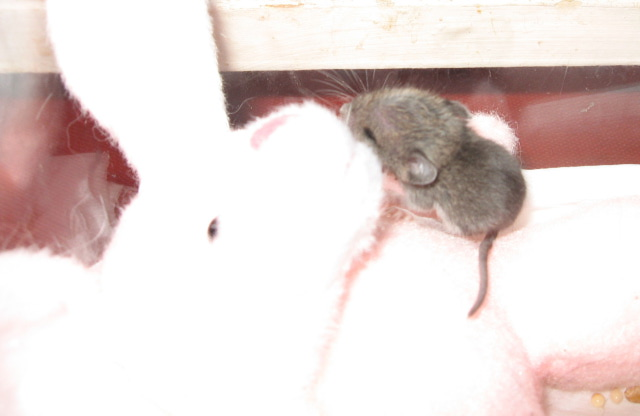 found baby mouse
Questionphoto of new mouse
QUESTION: Hi Natasha!
found baby mouse
Questionphoto of new mouse
QUESTION: Hi Natasha!
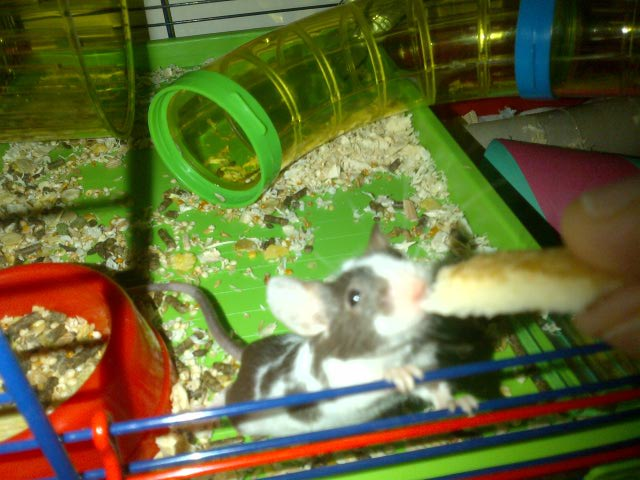 Mouse diet
QuestionSharing Dads lunch
Scattered Food
Mouse diet
QuestionSharing Dads lunch
Scattered Food
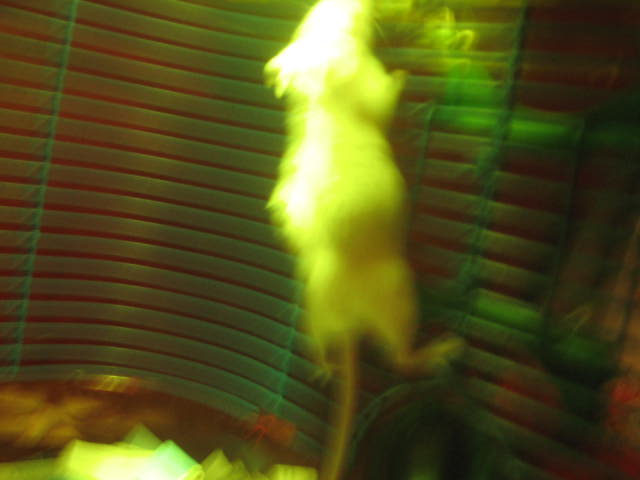 Wild mouse romanced tame fancy mouse girls
QuestionLittle lilly
QUESTION: Hello, I recently
Wild mouse romanced tame fancy mouse girls
QuestionLittle lilly
QUESTION: Hello, I recently
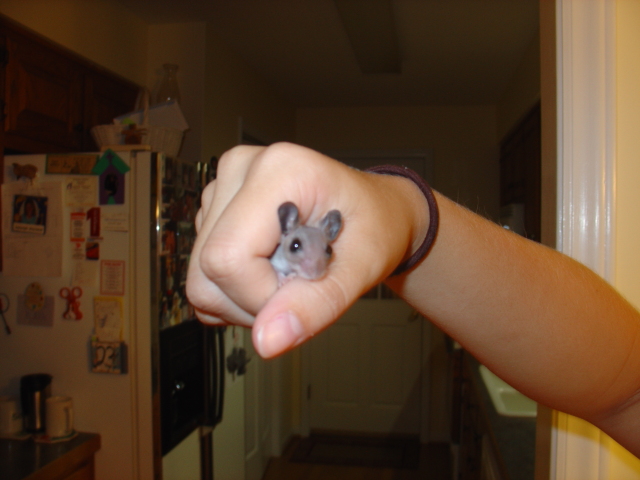 female deer mouse hoarding/weight loss
Question
Velveeta
Hi Natasha! First let me tell you you
female deer mouse hoarding/weight loss
Question
Velveeta
Hi Natasha! First let me tell you you
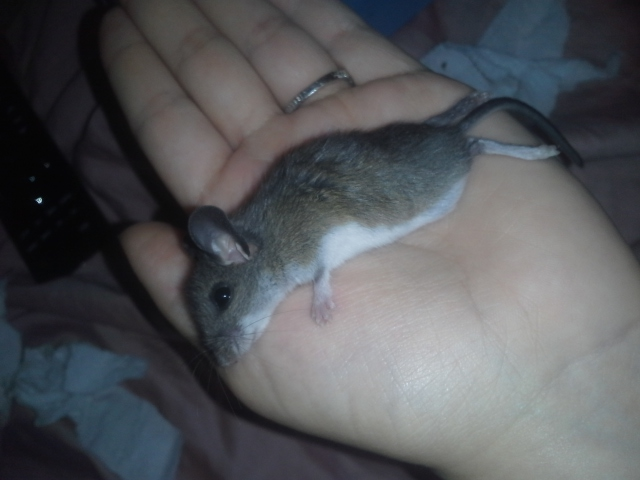 cat brought in injured wild mouse
Question
mouse
Hi,
My name is Alexandria and to
cat brought in injured wild mouse
Question
mouse
Hi,
My name is Alexandria and to